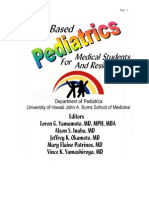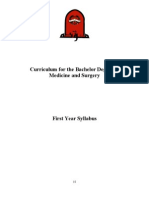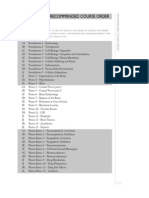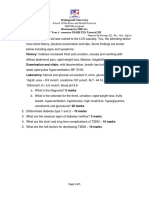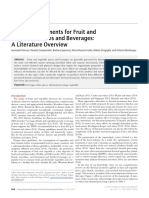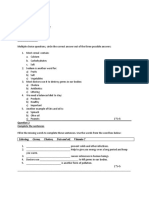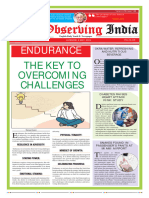0 ratings0% found this document useful (0 votes)
79 viewsList of Lectures
List of Lectures
Uploaded by
Maria Grazia GrechThe document outlines the modules studied throughout the year for several medical disciplines, including Integrated Biomedical Sciences, Pharmacology, Microbiology, Gastrointestinal System, Nervous System, Introduction to Clinical Practice, Metabolism and Endocrinology. For each discipline, the modules cover topics in anatomy, physiology, pathology, and clinical/diagnostic skills. Some examples include the scientific method, microbiology laboratory skills, gastrointestinal motility, neural function of the retina, patient rights, and the thyroid gland.
Copyright:
© All Rights Reserved
Available Formats
Download as DOCX, PDF, TXT or read online from Scribd
List of Lectures
List of Lectures
Uploaded by
Maria Grazia Grech0 ratings0% found this document useful (0 votes)
79 views6 pagesThe document outlines the modules studied throughout the year for several medical disciplines, including Integrated Biomedical Sciences, Pharmacology, Microbiology, Gastrointestinal System, Nervous System, Introduction to Clinical Practice, Metabolism and Endocrinology. For each discipline, the modules cover topics in anatomy, physiology, pathology, and clinical/diagnostic skills. Some examples include the scientific method, microbiology laboratory skills, gastrointestinal motility, neural function of the retina, patient rights, and the thyroid gland.
Original Description:
bbb
Copyright
© © All Rights Reserved
Available Formats
DOCX, PDF, TXT or read online from Scribd
Share this document
Did you find this document useful?
Is this content inappropriate?
The document outlines the modules studied throughout the year for several medical disciplines, including Integrated Biomedical Sciences, Pharmacology, Microbiology, Gastrointestinal System, Nervous System, Introduction to Clinical Practice, Metabolism and Endocrinology. For each discipline, the modules cover topics in anatomy, physiology, pathology, and clinical/diagnostic skills. Some examples include the scientific method, microbiology laboratory skills, gastrointestinal motility, neural function of the retina, patient rights, and the thyroid gland.
Copyright:
© All Rights Reserved
Available Formats
Download as DOCX, PDF, TXT or read online from Scribd
Download as docx, pdf, or txt
0 ratings0% found this document useful (0 votes)
79 views6 pagesList of Lectures
List of Lectures
Uploaded by
Maria Grazia GrechThe document outlines the modules studied throughout the year for several medical disciplines, including Integrated Biomedical Sciences, Pharmacology, Microbiology, Gastrointestinal System, Nervous System, Introduction to Clinical Practice, Metabolism and Endocrinology. For each discipline, the modules cover topics in anatomy, physiology, pathology, and clinical/diagnostic skills. Some examples include the scientific method, microbiology laboratory skills, gastrointestinal motility, neural function of the retina, patient rights, and the thyroid gland.
Copyright:
© All Rights Reserved
Available Formats
Download as DOCX, PDF, TXT or read online from Scribd
Download as docx, pdf, or txt
You are on page 1of 6
Modules Studied Throughout the Year:-
MDS 2020: Integrated Biomedical Sciences
1. The Scientific Method and an Introduction to the History of Science- GG
2. Hypothesis and Prediction Making- RM
3. Testing Hypotheses and their Predictions- PSW
4. Primary and Other Sources of Scientific Information- RC
5. Reading a Scientific Paper GDG
6. Reading a Clinical Paper IS
7. Reviews and the Uses of Secondary Information- MC
8. Writing a Scientific paper NV
9. Writing a Scientific Review JCA
10. Ethics and Professionalism in Research PM
11. Methodology of Dissection - PSW
MDS 2009: Pharmacology
1. Fundamental Concept of Pharmacology- JM (week 8)
2. Aspects of Drugs Disposition- JM
3. Drugs Development and Clinical Trials- CS
4. What is LADME?- JM
5. Drug Dosage Regimens- JM
First Semester:-
MDS 2004: Microbiology
1. An Introduction to Microbial Genetics- PVC
2. Proper Use of the Microbiology Laboratory- PFC
3. Transmission of Infectious Diseases- MAB
4. Sterilization and Disinfection- ?
5. Community Vaccines 1+2- PVC
6. CTS: Urinary Tract Infection- PVC
7. Prevention and Control of Heath care-Associated Infections- MAB
8. CTS: Device-Associated Infections- MAB
9. CTS: Vaccines PVC
10. CTS: Sampling Techniques for Microbiological Investigations- PFC
11. CTS: Hand Hygiene- ?
Bacteriology
1. Bacterial Morphology- PVC
2. Visualizing Bacteria, Bacterial Taxonomy- PVC
3. Gram Negative Bacteria 1: Enterobacteriaceae- PFC
4. Gram-negative Bacteria 2: Leptospira, Brucella, Bordetella, Haemophilus, Neisseria and
Legionella- MAB
5. Gram-positive Bacteria 1: Staphylococcus, Streptococcus and Enterococcus- MAB
6. Gram-positive Bacteria 2: Listeria, Bacillus, Corynebacterium, Mycobacterium and Nocardia-
PFC
7. Atypical Bacteria: Chlamydia, Rickettsia and Mycoplasma- PFC
8. Anaerobic Bacteria- PFC
9. CTS: Tuberculosis- PFC
Virology
1. General Properties of Viruses- CB
2. Important DNA Viruses and Associated Infections 1+2- CB
3. Important RNA Viruses and Associated Infection 1+2- CB
4. CTS: Virology- CB
5. CTS: Laboratory Diagnosis of Viral Infections CB
MDS 2021: Gastrointestinal System
1. Introductory Lecture
Anatomy
1. Embryology of GIT- JCA
2. CTS: Congenital Anomalies of the GIT- JCA
3. Histology of the GI System- CP
4. CTS: Histology of the GI Tract- KBT
5. Microscopic Anatomy of Normal Liver and Histological Evaluation in Fatty Change
Experimental Models- Prof. Capello
6. Oesophagus and Stomach Structure- IS
7. Peritoneal Reflections and Surface Anatomy of the GIT- IS
8. Duodenum and Pancreas- IS
9. Dissection: Stomach, Duodenum and Pancreas- MTC
10. Liver and Biliary System- IS
11. CS: Surface Projections of the GI Tract- IS
12. CTS: Peptic Ulcer- AM
13. Small and Large Intestine- IS
14. Imaging of Upper and Lower GIT- IS
15. CTS: Pancreatitis - Acute/Chronic- AM
16. Dissection: Liver and Biliary System- MTC
17. CTS: Appendicitis and Peritonitis, Diverticulitis and Colorectal Cancer- IS
18. Drug Metabolism, P450 Enzymes and Metabolism- JM
19. Rectum and Anal Canal- IS
20. Patterns of Blood Supply- IS
21. Dissection: Small intestine and Colon- MTC
22. Patterns of Nerve Supply- IS
23. CS: Imaging of the Upper GIT- IS
24. CTS: Jaundice=> Obstructive and Non-Obstructive Cases- JB
25. CS: Clinical Examination of the GI Tract (Including Rectal Exam)- IS
26. CTS: Case History=> Alcohol and the Digestive Tract- J Bonello
27. CS: Imaging of the Lower GIT- MTC
28. Seminar: Presentation and Discussion of Clinical Cases- TA/PE
29. Dissection: Transverse Sections-?
30. Quiz: Imaging- IS
Physiology
1. Overview of General Function of the GIT- SC
2. Chewing Function of the Tongue, Saliva, Swallowing, Vomiting- SC
3. Oesophagus and Stomach Motility- SC
4. Gastric Secretion- SC
5. Bile, Pancreatic Secretions- SC
6. Digestion and Absorption- SC
7. Water and Electrolyte Absorption and Secretion- SC
8. Liver Function- SC
9. Gastrointestinal Motility, Including Defecation- SC
10. Neurohumeral Regulation- SC
11. Intestinal Mucosal Immunology and Ecology- SC
12. CTS: Motility disorders and IBS- JB
13. An Overview of Pathology of the Gastro-Intestinal Tract- BE
14. Quiz: Physiology- SC
MDS 2022: Introduction to Clinical Practice:
1. Patients Rights 1+2- PM
2. The Biopsychosocial Model- DC
3. Truth Telling- PM
4. CTS: Beginning of Life- RZ
5. Anthropological Issues in Bioethics- RZ
6. Confidentiality- PM
7. Reproductive Issues- PM
8. Human Reproduction- PM
9. Adolescence , Adulthood, Middle Age and Elderly- RZDD
10. Life, Death, Dying and Killing- PM
11. CTS: End of Life- PM
12. Equality- PS
13. Changing Patterns and Measurement of Health- FA
14. Emotions and Sexuality- Marija Axiak
15. Children- PM
16. Social Class, Gender and Ethnicity- FA
17. Concepts of Health- PS
18. Ethical Reasoning- PM
19. Quality of Life- FA
20. Risk Taking- PS
21. Cultural Issues in Ethics- PM
22. Learning, Perception, Development of Thinking- CS
23. Giving News- PS
24. Smoking, Food, Alcohol, Drugs- MS
25. Health Beliefs- FA
MDS 2023 + 2027: Nervous System
Anatomy
1. Overview of the CNS and Cranial Nerves- CZ
2. The Skull 1+2- MTC
3. Radiology of the Skull and Vertebral Column- RP
4. Dissection: The Skull- MTC
5. The Meninges and CSF Pathways- CZ
6. CTS: Head Injury- CZ
7. Nose and Paranasal Sinuses- MTC
8. CTS: Nose and Paranasal Sinuses- IS
9. Dissection: Nose, Sinuses and Pharynx- MTC
10. The Scalp, Face, Parotid Gland, Mandible and Temporomandibular Joint- MTC
11. Temporal and Infratemporal Fossa and Pterygopalatine Fossa 1+2- IS
12. Dissection: Temporal fossa, Infratemporal fossa and Pterygopalatine fossa- MTC
13. Dissection: Facial Muscles, Parotid Gland, Facial Nerve, TMJ and Muscles of Mastication-
MTC
14. Oral Cavity, Tongue and Submandibular Region- MTC
15. The Palate and Pharynx- MTC
16. The Larynx- MTC
17. Dissection: Larynx and Neck Vessels- MTC
18. Deep Cervical Fascia, Triangles of the Neck and Cervical Plexus- MTC
19. Viscera and Vasculature of the Neck- MTC
20. Dissection: Triangles of the neck- MTC
21. CTS: Lumps in the Neck- IS
22. Cerebrum I: External Appearance and Cellular Organisation CZ
23. Cerebrum II: Cortical Localization of Function CZ
24. CS: Examination of Nose, Sinuses, Mouth, Pharynx and Neck- JCA
25. The Orbit and the Eyeball- CZ
26. Muscles of the Eye and Eye Movements- CZ
27. CS: Examination of the Eye- CZ
28. CTS: Problems Affecting Visual Pathways- CZ
29. Dissection: Orbit and the Eyeball- MTC
30. CS: Head (Including Skull and Soft Tissues) and Vertebral Column Imaging- JCA
31. CTS: Problems Regarding Sensation in the Face and Facial Palsy- IS
32. External and Middle Ear- MTC
33. Inner Ear- MTC
34. CTS: The Ear- IS
35. Dissection: The ear
36. CS: Examination of the Ear- JCA
Physiology
1. Taste and Olfaction GDG
2. Receptors and Modalities of Sensation RM
3. Cognition and Cortex GDG
4. Central Visual Pathways CZ
5. Neural Function of the Retina RM
6. Central Neurophysiology of Vision RM
7. Central Auditory Pathways CZ
8. Physiology of Hearing- NV
MDS 2025: Intrapersonal Communication Skills
Behavioural Sciences Seminar
MDS 2026: Integrated Metabolism and Endocrinology
Metabolism
1. Nutrition and Energy Expenditure- TH
2. Aerobic Glycolysis 1+2+3- TH
3. TCA Cycle- TH
4. Electron Transport Chain and Oxidative Phosphorylation- TH
5. Glycogen metabolism- TH
6. Gluconeogenesis- TH
7. Pentose Phosphate Pathway and Sugar Metabolism- TH
8. Regulation of Glucose Metabolism- TH
9. Lipids as a Source of Fuel- TH
10. Ketone Bodies- TH
11. Fatty Acid Synthesis and Fat Storage- TH
12. Regulation of Fat Metabolism- TH
13. CTS: Metabolic Switching- TH
14. Alcohol Metabolism- TH
15. Oxygen Toxicity- GJH
16. Transamination and Urea Metabolism- TH
17. Amino Acid Carbon Skeleton- TH
18. CTS: Energy Boost- TH
19. Deficiencies of Water-Soluble Vitamins- GJH
20. CTS: Deficiencies of Water-Soluble Vitamins- GJH
21. Specialized Amino Acid Derivatives- TH
22. CTS: Inborn Errors of Metabolism- TH
23. Integration of Metabolism 1- TH
Endocrinology
1. Molecular Mechanism of Hormone Action- JV
2. Endocrine Pancreas- JV
3. Maintenance of Blood Glucose- JV
4. CTS: Aberrant Glucose Metabolism and Metabolic Acidosis- JV
5. Adipose as an Endocrine Organ- JV
6. Hypothalamus- JV
7. The Anterior and Posterior Pituitary Gland- JV
8. The Thyroid Gland- JV
9. The Parathyroid Glands- JV
10. The Adrenal Glands- JV
11. Seminar: Metabolic Syndrome- JV
12. Seminar: Multihormonal Response During Stress- JV
Second Semester:-
MDS 2008: Pathology
You might also like
- Samson Handbook of PLAB 2 and Clinical AssessmentFrom EverandSamson Handbook of PLAB 2 and Clinical AssessmentRating: 4.5 out of 5 stars4.5/5 (8)
- Dr. Sebi's Book of Remedies II - Kerri M. WilliamsDocument146 pagesDr. Sebi's Book of Remedies II - Kerri M. WilliamsLuis Horn100% (10)
- Test Bank For Guyton and Hall Textbook of Medical Physiology 13th Edition by John e Hall 005 2Document7 pagesTest Bank For Guyton and Hall Textbook of Medical Physiology 13th Edition by John e Hall 005 2Richard Meyers96% (48)
- B.SC in Operation Theatre and Anesthesia Technology PDFDocument24 pagesB.SC in Operation Theatre and Anesthesia Technology PDFSudhakar100% (2)
- Pedtext 5Document716 pagesPedtext 5jay_eshwa100% (1)
- Aspartame Literature ReviewDocument10 pagesAspartame Literature Reviewapi-272556824No ratings yet
- Lab Report Basic Stock Soup & SaucesDocument12 pagesLab Report Basic Stock Soup & SaucesAliabdrahimNo ratings yet
- Inicet Fats & Pyq TopicsDocument70 pagesInicet Fats & Pyq TopicsAslesh AnandNo ratings yet
- Curriculum For The Bachelor Degree in Medicine and SurgeryDocument21 pagesCurriculum For The Bachelor Degree in Medicine and SurgeryIbrahim00No ratings yet
- Final IndexDocument58 pagesFinal IndexDarshan KumarNo ratings yet
- Course OrderDocument6 pagesCourse OrderShaz ChindhyNo ratings yet
- General Pathology Theory Syllabus For II B.D.SDocument9 pagesGeneral Pathology Theory Syllabus For II B.D.SAditya KhullarNo ratings yet
- ZENICADocument72 pagesZENICAVedadNo ratings yet
- DR ZV Ma'am's LECTURE All Links (MED CLUB)Document18 pagesDR ZV Ma'am's LECTURE All Links (MED CLUB)ttjngpb56jNo ratings yet
- MedicineDocument3 pagesMedicineAditya N. ShindeNo ratings yet
- Fmge December 2017: Syllabus: Pre and para Clinical Subjects AnatomyDocument14 pagesFmge December 2017: Syllabus: Pre and para Clinical Subjects AnatomyVivek DevendarNo ratings yet
- Systemic PathologyDocument9 pagesSystemic PathologySanath KellyNo ratings yet
- The-File - 4Document69 pagesThe-File - 4rockeyNo ratings yet
- 22 - BMLT (Wbuhs)Document21 pages22 - BMLT (Wbuhs)mmisspritirakselNo ratings yet
- Syllab BSC Dialtech1819-22102018Document22 pagesSyllab BSC Dialtech1819-22102018Salem Polyclinic KNo ratings yet
- INICET PLAN - RemovedDocument31 pagesINICET PLAN - RemovedVipul KhajuriaNo ratings yet
- Online Test Series For Neet PG 2021 1Document5 pagesOnline Test Series For Neet PG 2021 1Ritesh DeshmukhNo ratings yet
- Pathology MUHS Questions (2005-2015)Document5 pagesPathology MUHS Questions (2005-2015)Shahid KhanNo ratings yet
- Mbbs Pathology QuestionsDocument11 pagesMbbs Pathology QuestionsAli KhanNo ratings yet
- Syllabus For Paper I & Ii For M.B.B.S Course Subject - AnatomyDocument10 pagesSyllabus For Paper I & Ii For M.B.B.S Course Subject - AnatomyPreetam PaulNo ratings yet
- Dip 1 Yrsyllabus 2011Document9 pagesDip 1 Yrsyllabus 2011Manchala RaviNo ratings yet
- Class Links DoctorDocument15 pagesClass Links Doctorgrahul2199No ratings yet
- Conservative Dentistry and Endodontics 121118Document9 pagesConservative Dentistry and Endodontics 121118Dr. Shaili MehtaNo ratings yet
- Important Topics To Study For Fmge Exam: AnaesthesiaDocument11 pagesImportant Topics To Study For Fmge Exam: AnaesthesiaPrepladder ChyNo ratings yet
- Systemic PathoDocument6 pagesSystemic Pathoxawopa2607No ratings yet
- Mci Screening Test SyllabusDocument9 pagesMci Screening Test Syllabusravi sharma100% (2)
- Wa0086Document8 pagesWa0086JosephNo ratings yet
- Cardiac CareDocument6 pagesCardiac CareMemon RazakNo ratings yet
- MDSC 1001 Course OutlineDocument4 pagesMDSC 1001 Course OutlineMichael TimsonNo ratings yet
- PathologyDocument5 pagesPathologySatchit DwivediNo ratings yet
- Syllabus of 1st Internal Exam MBBS 2023Document3 pagesSyllabus of 1st Internal Exam MBBS 2023wnh4rpky5rNo ratings yet
- BPT Syllabus PDFDocument99 pagesBPT Syllabus PDFAbhishek NegiNo ratings yet
- Pre and para Clinical Subjects Marks 100: AnatomyDocument9 pagesPre and para Clinical Subjects Marks 100: Anatomybabu_rajanNo ratings yet
- Physiology Paper 1 Question BankDocument8 pagesPhysiology Paper 1 Question BankVeshalinee100% (1)
- 00 Course OrderDocument6 pages00 Course OrderEvelin YaritzaNo ratings yet
- Syllab Otat 08122020Document24 pagesSyllab Otat 08122020priyasamuel2312No ratings yet
- Syllabus For Preliminary Examination of Civil Services - Medical ScienceDocument2 pagesSyllabus For Preliminary Examination of Civil Services - Medical ScienceTAMILNo ratings yet
- Otolaryngology-Head & Neck Surgery Syllabus (BCPS)Document12 pagesOtolaryngology-Head & Neck Surgery Syllabus (BCPS)monirul islam shohanNo ratings yet
- List OF Topics: Mbbs Phase 1Document6 pagesList OF Topics: Mbbs Phase 1Codillia CheongNo ratings yet
- SyllabusDocument44 pagesSyllabusom vermaNo ratings yet
- Syllabus: BDS Course ContentDocument24 pagesSyllabus: BDS Course ContentlaishrampraveenNo ratings yet
- Biochem Exam Topics Dent 2022Document4 pagesBiochem Exam Topics Dent 2022znycdr5kc8100% (1)
- Neet PG Pyq Repeated TopicsDocument7 pagesNeet PG Pyq Repeated TopicsamalshajeezNo ratings yet
- Diabetes TutorialDocument1 pageDiabetes TutorialEmmanuel ChendaNo ratings yet
- FMGE 2019 SyllabusDocument7 pagesFMGE 2019 SyllabusHunt RocksNo ratings yet
- Module 2 - Symptoms and Syndromes in Diseases of Internal OrgansDocument133 pagesModule 2 - Symptoms and Syndromes in Diseases of Internal OrgansХассан ЯасирNo ratings yet
- Booklist NMC 12-13Document13 pagesBooklist NMC 12-13mksharmaaNo ratings yet
- Semester 3 Haemopoietic & Lymphatic System: AnatomyDocument11 pagesSemester 3 Haemopoietic & Lymphatic System: AnatomyFarhan IzaniNo ratings yet
- VPB 111Document3 pagesVPB 111Dr-Ashok KeerNo ratings yet
- File 1Document10 pagesFile 1Atul KumarNo ratings yet
- Multiple Sclerosis: Practical Comprehensive EssentialsFrom EverandMultiple Sclerosis: Practical Comprehensive EssentialsRating: 3 out of 5 stars3/5 (1)
- Biomedical Sciences: Essential Laboratory MedicineFrom EverandBiomedical Sciences: Essential Laboratory MedicineRaymond IlesNo ratings yet
- Primer on the Metabolic Bone Diseases and Disorders of Mineral MetabolismFrom EverandPrimer on the Metabolic Bone Diseases and Disorders of Mineral MetabolismNo ratings yet
- Nursing Care Plan Otitis MediaDocument3 pagesNursing Care Plan Otitis Mediaevi nur laili100% (2)
- Calcium X Volume UpDocument4 pagesCalcium X Volume UpsheldonNo ratings yet
- 100-Ab-Workouts-By-Darebee - Copy-1-40Document40 pages100-Ab-Workouts-By-Darebee - Copy-1-40johny johnyq100% (2)
- Influence of Feed Protein Content Level, To Assess Growth Performance of Nile Tilapia (Oreochromis Niloticus, Recirculating SystemDocument18 pagesInfluence of Feed Protein Content Level, To Assess Growth Performance of Nile Tilapia (Oreochromis Niloticus, Recirculating SystemCatalina CiortanNo ratings yet
- Refrensi Pasteurisasi Nanas Dalam KalengDocument24 pagesRefrensi Pasteurisasi Nanas Dalam Kalengdafik adam masruriNo ratings yet
- The Rise of Keeping KosherDocument5 pagesThe Rise of Keeping Kosherapi-291369824No ratings yet
- Skac 422Document11 pagesSkac 422Sofia Marilyn Castillo ParraNo ratings yet
- Dental Management of Children Undergoing Liver TransplantationDocument9 pagesDental Management of Children Undergoing Liver Transplantationwahyudi_donnyNo ratings yet
- Reverse Dieting 101Document6 pagesReverse Dieting 101Romain TRUONGNo ratings yet
- Assignment 3 - Milestone 2 - Multimedia DevDocument2 pagesAssignment 3 - Milestone 2 - Multimedia DevMolly SantosNo ratings yet
- Physiotherapy in PCOSDocument54 pagesPhysiotherapy in PCOSAkshaya Nayak100% (3)
- HRM 56 - Fundamentals of Plating - Flores X NisnisanDocument4 pagesHRM 56 - Fundamentals of Plating - Flores X Nisnisanghee05No ratings yet
- Disaccharide - An Overview - ScienceDirect TopicsDocument11 pagesDisaccharide - An Overview - ScienceDirect TopicsLord ASBNo ratings yet
- Empire Builder Dining Car Menu 0515Document2 pagesEmpire Builder Dining Car Menu 0515Ajie Mohammad Yuki TakegawaNo ratings yet
- Nutrient-Drug InteractionsDocument10 pagesNutrient-Drug Interactionsapi-353723892No ratings yet
- Fit For Life - Food CombiningDocument6 pagesFit For Life - Food CombininghistorymakeoverNo ratings yet
- What Is Nephrotic Syndrome?: NephroticsyndromeDocument8 pagesWhat Is Nephrotic Syndrome?: NephroticsyndromeSiva GanaNo ratings yet
- Proana Websites PresentationDocument11 pagesProana Websites Presentationb1gbrotherNo ratings yet
- Ruba Ali - Refuel Nutrition GuideDocument15 pagesRuba Ali - Refuel Nutrition GuideShahenda El-MenshawyNo ratings yet
- Manuskrip Jurnal Terapi Nutrisi English VersionDocument22 pagesManuskrip Jurnal Terapi Nutrisi English VersionKhumaira SantaNo ratings yet
- SpirulinaDocument11 pagesSpirulinainland trustNo ratings yet
- KhadijatuDocument72 pagesKhadijatuMusa Umar YayeNo ratings yet
- Introduction To Vitamin C, (Chemistry STPM)Document2 pagesIntroduction To Vitamin C, (Chemistry STPM)NarmeenNirmaNo ratings yet
- Premium C1 Glossary: Unit Exercise English Headword Pronunciation Example Sentence Unit 01Document53 pagesPremium C1 Glossary: Unit Exercise English Headword Pronunciation Example Sentence Unit 01Chiqui-GraNo ratings yet
- True Observing India 6 May 2024Document8 pagesTrue Observing India 6 May 2024sanketjha491No ratings yet
- The Real Dirt On FarmingDocument63 pagesThe Real Dirt On FarmingThe London Free PressNo ratings yet
- Procedure:: Deped, Division of Lapu-Lapu CityDocument4 pagesProcedure:: Deped, Division of Lapu-Lapu CityJulie Maezar Aparre100% (4)





